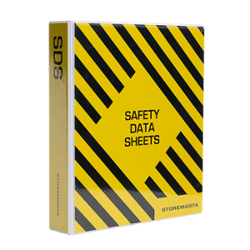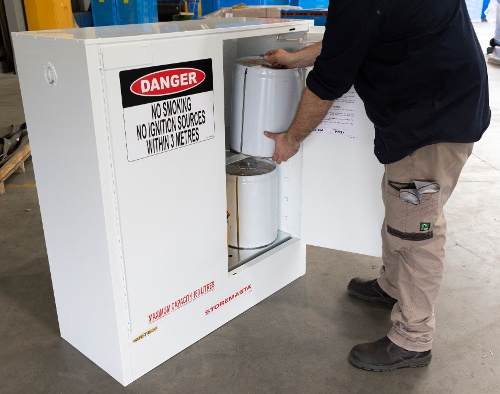As a high-tech piece of dangerous goods storage equipment, your chemical cabinet is designed to protect your business. Whether it’s from spills or vapour emissions, your cabinet is necessary for the safety of your staff, as well as the surrounding community and environment. But just like any piece of equipment, inspections and maintenance are necessary for ensuring the effectiveness of your cabinet. In this post, we list 6 signs that your chemical storage cabinet needs urgent attention, so you can better understand how to use and maintain your indoor store — and keep your workplace compliant.
1. The Doors Of The Cabinet Aren’t Closing Properly
Most classes of safety cabinets are equipped with self-closing, tight-fitting doors to assist with risk minimisation. These doors are also controlled by an automatic door closing system that allows the doors to shut tightly when they’re not being held open by staff.
This smart feature of your chemical cabinet assists with reducing the likelihood and impact of:
- Hazardous vapour emissions
- Spillage and leaks
- Theft, misuse and vandalism
- Damage to the cabinet contents
- Protection against incompatible chemicals
- A heat and fire barrier
However, if the doors of the cabinet aren’t closing properly – meaning closing automatically, in sequence and tightly – this is a big red flag that is telling you that there’s something not quite right about how you’re using or maintaining the cabinet.
There are a multitude of reasons why the doors aren’t closing as they should. Let’s look at some of the likely reasons behind why the door system isn’t working properly.
- Drums and chemical packages aren’t sitting properly on the shelves – if your cabinet is overcrowded, or packages are hanging over the edge, then the door system may be inhibited by the contents of the cabinet.
- FIX: This is one of the easiest fixes to rectify when it comes to the functioning of the self-closing doors. Simply check that you’re not overloading your cabinet (check the maximum capacity rating) and ensure that all chemical drums and packages are neatly placed on the shelves without impeding the doors or the closing mechanisms.
- There has been physical damage to the doors/closing mechanisms – in the event of your cabinet suffering impact damage, such as a vehicle knocking into the cabinet, you may notice that the doors aren’t able to shut properly. This could be because the actual door is dented or the closing mechanisms aren’t operating as they should.
- FIX: Any damage to the cabinet must be noted and repaired, as the effectiveness of the cabinet is reliant on the safety features being in good working order. Speak with your manufacturer about spare parts or how to repair (or replace) the unit.
- The adjustment of mechanism/closer speed – the adjustment of the doors’ automatic closing mechanism may affect the way the stores are shutting.
- FIX: You may need to adjust your door closer to speed up or slow down. All STOREMASTA cabinets are QC tested prior to dispatch. This includes the testing and adjusting of the door closing system. Alternatively, if the cabinet isn’t sitting level, it can affect the speed of the closing system and the alignment.
2. There’s A Strong Smell When You Open The Doors
One of the most important considerations when storing any type of dangerous goods or hazardous substance is the level of airborne contaminants inside your cabinet.
If staff are noticing a strong smell when they access the cabinet, it’s a sign that there is a high level of hazardous vapours present within the store.
Check to see if you can rectify the situation yourself by checking:
- Is the cabinet overloaded past the maximum capacity?
- Do all chemical packages have tight fitting lids which are properly closed?
- Is there any residue present on the shelves, walls or packages?
- Has the spill containment sump got any hazardous substance in it?
- Are the correct chemicals being stored in the cabinet?
If these measures aren’t affecting the concentrated vapours present in the cabinet, you should conduct a risk assessment immediately to determine if your cabinet requires a mechanical ventilation system.
Until this can be actioned, we suggest removing a large portion of the stored products into another suitable safety cabinet or a well-ventilated store.
And remember, just because you don’t smell hazardous vapours, it doesn’t mean that they aren’t present. Many chemicals emit vapours which have no smell at all. However, these vapours can still cause physical damage to staff who are exposed to them. If you’re unsure of your obligations in regards to airborne contaminants in your storage areas, refer to Safe Work Australia’s workplace exposure standards.
3. Your Signage Is Damaged or Missing
All safety cabinets come equipped with the applicable dangerous goods and hazard signage. This will usually include your:
- Dangerous goods diamond featuring the class of your goods
- Hazard signage which illustrates any prohibited practices near the cabinet, such as ignition sources and smoking
You’re required, under WHS Regulations and the Australian Standards, to have visible, intact signage on your stores.
If your signage has been damaged or has gone missing, it’s your responsibility to have it replaced immediately. Without the required signage on your store, your staff will not be aware of the hazards associated with the particular chemicals kept in your store.
4. There Are No SDS Nearby
Adding to our previous point about compliant signage, you’re also obliged to have the Safety Data Sheets (SDS) of each chemical stored in the cabinet within easy reach of your store.
This is due to two key factors:
- Correct chemical and hazard identification for staff
- Information for emergency services if there is an incident at your site
While the SDS are important documents that are required under WHS Regulations, just like any other type of paperwork, they can go missing. Therefore, it’s a good idea to keep your SDS in a dedicated and clearly marked folder, which is then stored in a document holder that’s attached to (or near to) your indoor chemical cabinet.

Your SDS must be available to any staff or emergency services that require them.
REMEMBER: If there are any new or substituted chemicals in your store, you must ensure that your SDS folder is updated with the new information. Chemicals can differ in their properties and hazards depending on the type of chemical, as well as the chemical manufacturer. Always keep your chemical documents up-to-date, so you can minimise risk in your stores.
5. Your Cabinet Appears Unstable
If your cabinet is wobbly or appears even slightly unstable, this is an issue that needs to be rectified as soon as possible. Unstable storage can cause a wide range of risks through the contents of your store becoming unbalanced. If the cabinet is unable to function as it should, on an even, flat surface, then many aspects of your cabinet won’t be effective in risk reduction.
Unstable cabinets can result in spillage, hazardous vapour emissions, physical damage to the store — and the staff that open it. If the cabinet hasn’t been installed on an appropriate surface, you must choose a new location that allows the cabinet to stabilise.

Your cabinet must be installed on flat, even ground in order for the risk control measures to work properly.
Without the proper placement and installation, your cabinet won’t be able to provide adequate:
- Spill containment – the sump may leak or spill over if the footing is uneven
- Vapour control – the self-closing, tight-fitting doors won’t offer vapour containment if they’re prohibited from closing in the correct way
- Secure storage – cabinet shelving won’t be even and stable; the doors may not be able to be locked properly
6. The Cabinet Shows Signs Of Ageing
While many of us would like to be young forever, we must eventually come to the conclusion that ageing is inevitable. Likewise, your workplace safety cabinets can also suffer from signs of ageing or general wear and tear.
While cabinets are constructed from hardwearing sheet steel — and finished with a corrosion-resistant powder coating — there may be instances when your indoor cabinet needs to be put out of commission.
Signs that your cabinet may require a repair or replacement include:
- Dents or scratches
- Damaged cabinet components
- Chipped powder coating
- Corrosion
- Doors that aren’t closing properly
- Dented shelving
- Splits in the steel
- Spill sump not working correctly
IMPORTANT: If you’re unsure if you require a spare part, a repair or a completely new cabinet, get in touch with a Dangerous Goods Consultant or your preferred cabinet manufacturer for advice on how to rectify the cabinet’s structural issues.
Keeping Your Chemical Cabinets Compliant
While we’ve listed 6 signs that are obvious red flags that there’s something wrong with your chemical storage cabinet, there are many considerations you need to make when using and maintaining your safety cabinets. We always suggest creating procedures for the loading, stacking and general usage of your cabinet, as well as implementing a regular inspection and maintenance check list. Your checklist will help you keep on top of your compliance duties in regard to your indoor chemical cabinets.
If you’d like to find out more about caring for your cabinets, we have an easy-to-read eBook that can help. Essential Considerations When Storing Flammable Liquids Indoors will help you reduce risk with your flammable liquids storage cabinets by providing simple and actionable advice on how to select, install, use and maintain your cabinet. Get your copy of our guide for free today by clicking on the image below.
Joining the team as a Dangerous Goods Storage Consultant, Melissa Hampton became Storemasta's Marketing Manager in late 2021. With extensive knowledge and experience in chemical compliance, Melissa is responsible for leading the Marketing team and helping shape their marketing strategy. In her spare time, you can find Melissa hiking, swimming and enjoying the great outdoors in beautiful north-west Tasmania.

